Ulster Loyalist Handicraft Small Arms
For obvious reasons, the various groups in need of weapons, could not start the production of high-grade weapons, according to the characteristics comparable to the serial models of the "state" assembly. The lack of serious production capacity led to the need to select the most simple designs that could provide acceptable performance and reduce the complexity of production. Naturally, the simplest types of weapons developed by the British were one of the sources of borrowing by gunsmith handicraftsmen.
In the seventies, the Northern Irish police conducted several successful raids, during which several clandestine weapons workshops and armed cells that were part of loyalist organizations were discontinued. During these events, the police seized several curious samples of handicrafts small arms. Even experiencing serious difficulties in the field of engineering and technology, gunsmiths in the underground managed to make very interesting systems. Consider a few samples of such weapons.
It should be noted that for obvious reasons, gunsmiths-handicraftsmen could not independently develop high-grade weapons, and therefore were forced to copy various samples of factory production. Most often, comparatively simple submachine guns created during World War II or shortly thereafter became the copy model, above all STEN and Sterling. These submachine guns differed simplicity of design and relatively high performance. It is quite clear that it was them who began to copy the underground workshops. In addition, they often “shared” their aggregates that could be obtained under the existing conditions.
Handicraft STEN
The first of the samples, which we consider, is in fact a copy of the STEN submachine gun, modified in accordance with available technologies. There is no exact information about the origin of these weapons, but it is known that it was manufactured in the interests of one of the loyalist groups that “helped” the police and army to fight for the preservation of Northern Ireland within the United Kingdom.
The lack of access to industrial equipment forced unknown gunsmiths to use literally available materials and the same tools. The main part of the underground "Wall" was the most common pipe of the appropriate length, apparently, plumbing. In its front part with the help of four bolts the barrel was fastened (probably smooth and also from a suitable tube), the back cover of the receiver was fixed with a bolt and a nut. To accommodate various additional units in an improvised receiver, several windows were provided, and in the right surface there was a long slot for the shutter handle.
On the left side of the main pipe, by means of welding, fixed a small receiving shaft of the store with a spring-loaded latch. The simplest trigger mechanism was welded to the bottom of the receiver. To hold the weapon it was proposed to use a pistol grip and a vertical front grip. Both of these parts were also made of pipes.
The automatics of the handicraft submachine gun, as in the case of a full-fledged prototype, was based on a free gate. A massive, spring-loaded metal block with a drummer moved inside the receiver. Under the action of a recoil impulse, he had to move backwards, throw out the cartridge case and cling to the sear, or go forward again, sending out a new cartridge and firing a shot.
The handicraft “Wall” was used to fight through detachable box magazines chambered for 9x19 mm Para. Probably the store was the only piece of weapons not produced in the underground workshop. The store was placed in the side shaft and was fixed in its place by the latch of the simplest design.
The simplicity of production led to the fact that the underground weapons did not receive any sighting devices. There was also no stock or other fittings. Moreover, there was even a fuse. Thus, the submachine gun could be used in only one way. The shooter was supposed to arrive at the place of the "action", quickly get the hidden weapon, insert the magazine, cock in mechanisms and make one long line in the direction of the enemy. About the accuracy and accuracy of the battle did not have to say. In addition, you can doubt even the possibility of shooting the entire store without delays, misfires and other problems. After shooting the weapon could be thrown, not regretting the cost of its manufacture. Within a couple of hours, the master could make a new similar submachine gun for the next attack.
"Wall Invisible"
Artisanal weapons were used only for firing at large targets, such as a crowd of opponents, in urban environments with increased police attention. Thus, besides the ability to shoot, the secrecy of carrying was required. It seems that it was for this purpose that another “project” of a submachine gun for militants was created. A sample of such weapons was also taken by the police from loyalists in the seventies of the last century, when the demand for the future of Northern Ireland was in full swing ..
One of the main problems of STEN or Sterling submachine guns, as well as their copies from the point of view of concealed carry, was the lateral location of the store. Because of this, the weapon with the store could not be covertly worn under clothing. In addition, some problems with the carry could arise from the large size of these systems. The answer to these challenges was another handicraft submachine gun, built on the basis of the STEN system, taking into account the need for covert transportation.
The sample withdrawn by the police again received a receiver box made of a water pipe of the appropriate diameter. A sleeve was welded in its front end, connected to a smooth barrel of small length. Like other parts, the barrel was far from factory origin. Behind the receiver was closed with a round lid, fixed with a bolt. In the lower surface of the main pipe, two holes were provided for the magazine and for the firing mechanism. On the left there was a slot for the shutter handle.
The automatic shutter-based automation was again used. Inside the receiver was a massive cylindrical gate, interacting with a return-combat spring. The trigger mechanism, as in the previous case, had an extremely simple design and was not even equipped with a fuse, not to mention a translator of fire. Thus, the weapon posed a danger not only to enemies, but also to sloppy shooters and could not be safely transported with a side magazine.
A magazine with 9x19 mm cartridges was proposed to be placed in a small shaft on the underside of the weapon. In its place, it was fixed with a self-made latch. The design of the shaft and the latch was calculated taking into account the use of shops from a Sterling submachine gun. Compatibility with shops STEN was not provided.
Unlike the previous sample, the small-sized submachine gun had a vertically positioned magazine that could be used as an additional grip. This allowed to abandon a separate front handle and further reduce the size of the weapon. The main pistol grip retained a small length and small diameter, which made it difficult to hold the weapon.
Sights and any accessories are not provided. Shooting was offered from the hip and without aiming, which reduced the effectiveness of the fire, but fully met the requirements. The lack of sight, poor workmanship and a short barrel could not provide high performance, but there were enough available for shooting at the crowd of enemies.
Square Sterling
It is easy to see that the closest stores were the main supplier of parts for the underground weapons workshops in Northern Ireland. Apparently, the author of the following sample, having received an order from militant loyalists, did not find the necessary goods in the nearest shop, because of which he was forced to noticeably change the design of the weapon in comparison with the basic version. The result was a recognizable, but unusual design.
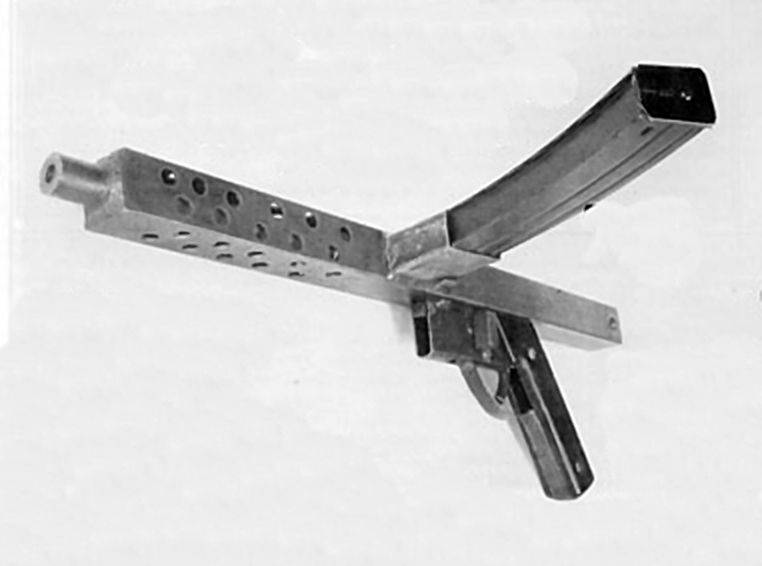
Copy of "Stirling" with a rectangular receiver
Without a round tube, the gunsmith took a different hire as a basis for the new weapon. A square tube was used as the main part for the new submachine gun. In front of her welded sleeve with a barrel, in the back - inserted plug, fastened with a bolt. Otherwise, except for the shape of some parts, the weapon was a fairly accurate copy of the Sterling submachine gun.
The front part of the receiver, thanks to a form completely justifying its name, received a perforation for cooling the barrel during firing. Behind the breech, on the left side, welded the shaft shop. Immediately behind it, but on the bottom surface, they installed an elongated casing of the firing mechanism, combined with a pistol grip.
It can be assumed that this weapon received a rectangular shutter fitted to the internal volume of the receiver. The bolt was held in the forward position by means of a back-fighting spring, and during firing it had to interact with the sear of the firing mechanism. In the back of the bolt there was a fixture for the handle extended through the slit of the receiver.
The square "Sterling" got a trigger mechanism developed in comparison with other samples. On its left surface a small handle was turned, rotating around its axis. This detail could occupy two positions, which allowed blocking mechanisms or firing in automatic mode. Shooting single was not envisaged because of the unwillingness to complicate the mechanisms of weapons.
Cartridges such as 9X19 mm Para were fed to the bolt and the trunk of a box magazine from a Sterling submachine gun. The store was proposed to be placed in a side shaft and fixed with an extremely simple design latch. Cartridges must have been thrown through a window in the right surface of the receiver.
When firing, such a weapon should be held by the magazine and the pistol grip. For more convenience, the arrow removed the sample even received a lining of the handle, mounted on a metal base. The butt of any design was not used. Similarly, there were no sights.
A submachine gun with a characteristic rectangular receiver was different from other similar weapons by its original appearance and more “advanced” trigger mechanism, which has locking systems. The real characteristics of this sample, however, apparently, were not high and did not differ from the parameters of other artisanal weapons used by the groups of Northern Ireland.
"Avenger"
The extremely simple design of the STEN and Sterling submachine guns allowed the gunsmiths to the underground workers not only to make various copies, but also to develop on their basis their own models of weapons that have significant differences from the base ones. A good example of this is the submachine gun called the Avenger ("The Avenger"), also seized from loyalists. This weapon differed from other self-made samples by its developed ergonomics and even by the presence of a silencer.
The Avenger received a square square receiver with a tightly sealed front end in which there was a hole for the barrel. In the bottom surface of the box there were windows for the magazine and the firing mechanism, at the top - for the release of the sleeves. The barrel was fixed in place with several screws in the breech and held in the desired position by means of a hole in the front wall of the box. The back wall of the box, apparently, was absent, and its functions were performed by the butt support part, or were in contact with the butt part. Provided for a rectangular shaft shop and a long casing of the firing mechanism, integrated with the pistol grip.
Traditionally, automation was based on the free shutter. The cartridges were supposed to be fed into the chamber with the help of a rectangular massive shutter moved by a returnable-fighting spring. There was no fuse, which did not contribute to the safe use of weapons, but facilitated their manufacture.
A box magazine from a STEN submachine gun, designed for an 9x19 mm cartridge, should be inserted into the lower receiving shaft. Spring-loaded lateral latch was designed specifically for such a store.
Unlike many other handicraft Northern Ireland submachine guns, the Avenger received both lining the pistol grip and a folding butt. The latter was mounted in the back of the receiver on a U-shaped support with an axis. Directly on the axis was a relatively large metal cylinder, to which two rods were welded. The free ends of the rods were connected to the L-shaped butt bracket. To reduce the size of the weapon when carrying the butt is formed by turning left forward. In this case, the rods were laid along the receiver, and the back plate turned into an additional front handle that facilitates the retention of the weapon.
Despite the presence of the stock, sights, as usual, were not provided. It was possible to conduct only off-target fire in a certain direction. Thus, in terms of the accuracy and accuracy of fire, the Avenger product was not very different from other handicraft weapons of Northern Irish armed organizations.
The most interesting feature of the Avenger submachine gun was the silencer. For the most secretive use of the unknown gunsmiths equipped their creation with this device for silent shooting. This device had the shape of an oblong cylinder with mounts for mounting on the barrel and the barrel in the front end. To install the muffler, the barrel part protruding from the receiver had an external thread. Inside the cylindrical body PBS located additional barrel, the muzzle of which had perforations for the discharge of gases into the cavity of the casing.
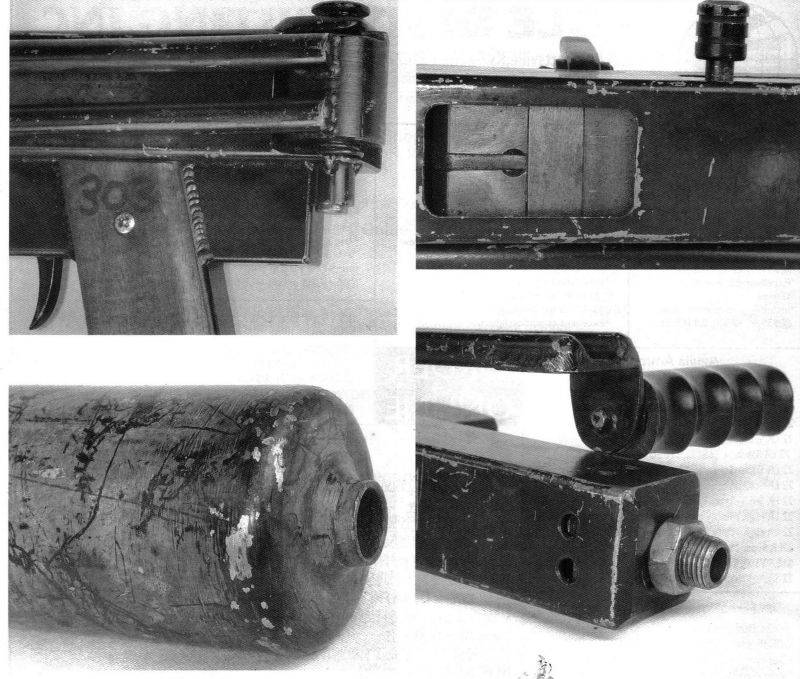
Different units of this submachine gun. Upper row: butt fixings and liner ejection window, lower row: muffler attachments
It was thanks to the original silencer that the police managed to find out about the creation of a new makeshift submachine gun. According to reports, the underground workshop was unable to make this device on its own, which is why the militants had to use their connections and order it to be made to employees of some kind of industrial enterprise. Intelligence agencies learned about this order and began to monitor further developments. After the finished product was handed over, the customer of the police managed to reach the workshop and the armed group for which the weapons were made. The militants were arrested and the “Avenger” seized.
***
Northern Ireland for several decades has been a field for the clash of several parties with different interests. Only in 1998, did the opponents manage to reach an agreement, which led to the cessation of attacks and bloodshed. Over the decades of open conflict, several hundred attacks have been carried out, to which the police responded with a mass of raids, special operations and arrests. The result of police measures to neutralize armed groups was the seizure of a large number of very different weapons, primarily self-made. Handicraft submachine-guns, explosive devices, and even unguided rockets were sent to warehouses of material evidence.
Parties to the conflict showed remarkable ingenuity in creating means of destroying the enemy. The above machine guns are in fact only the tip of the iceberg, known for the work of the police. It is not known how many similar samples were used and later destroyed by the operators themselves or still lie in hiding places and waiting for the renewal of the conflict.
Fortunately, the signing of the Belfast Agreement made it possible to stop an open confrontation in Ulster. The Northern Ireland conflict was not fully resolved, but managed to translate it into the sphere of peace negotiations. The need to manufacture our own weapons has disappeared, so interesting, but deadly handicrafts are now lying in warehouses and in museums and, fortunately, are no longer used in their intended purpose.
On the materials of the sites:
http://world.guns.ru/
http://forum.guns.ru/
http://guns.wikia.com/
http://strangernn.livejournal.com/
https://amodestpublication.wordpress.com/
- Ryabov Kirill
- Strangernn.livejournal.com, Forum.guns.ru
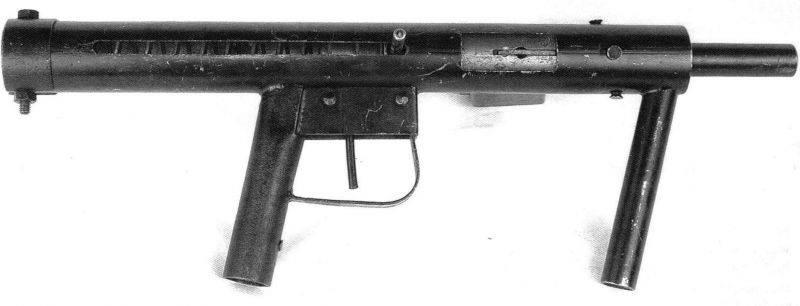
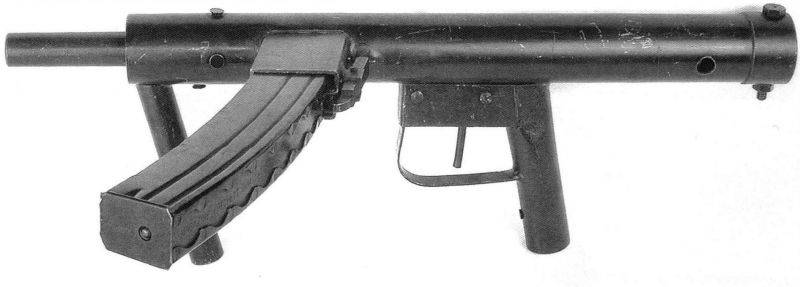
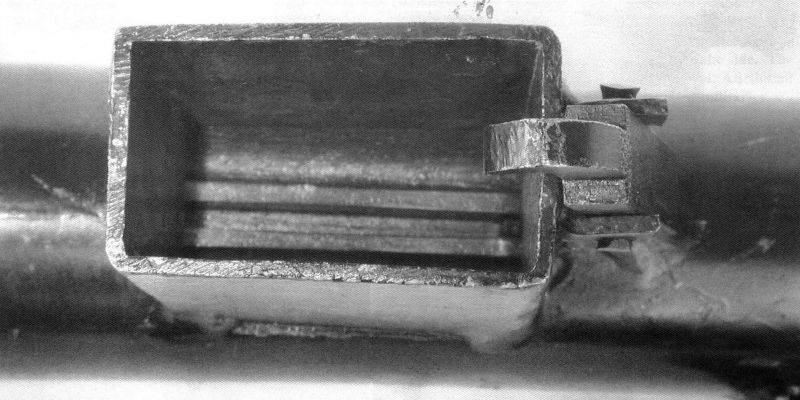
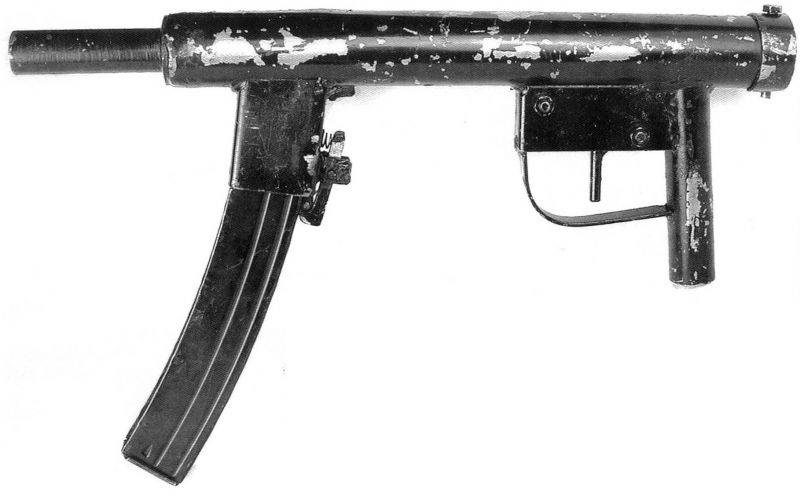
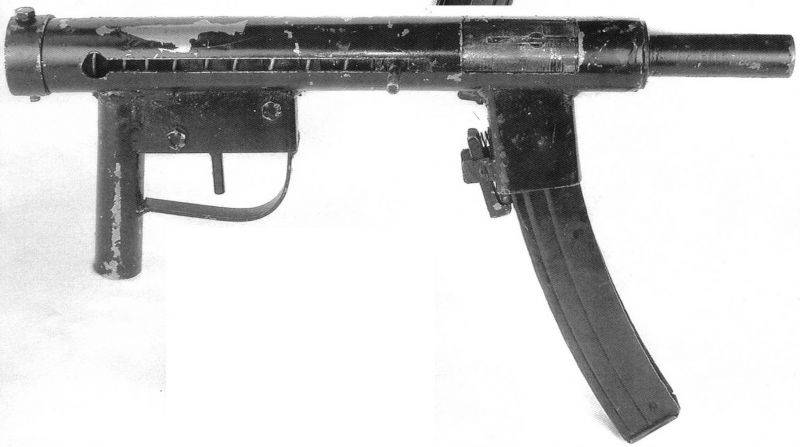
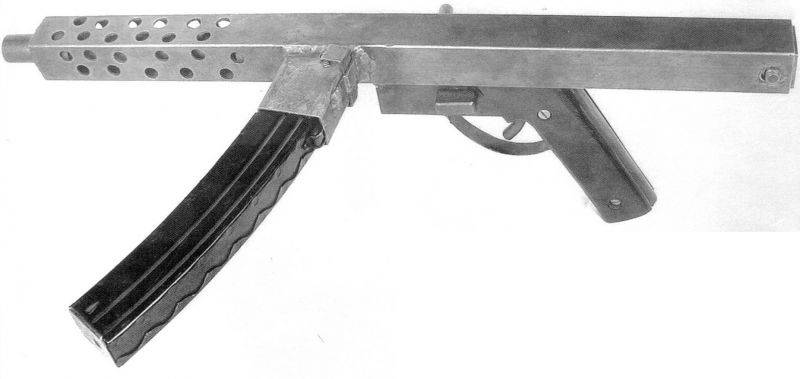
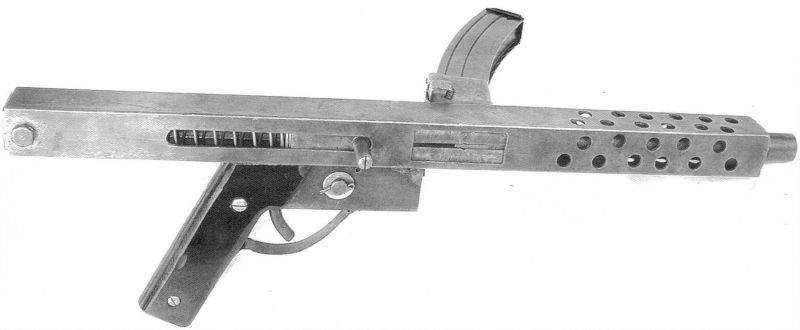
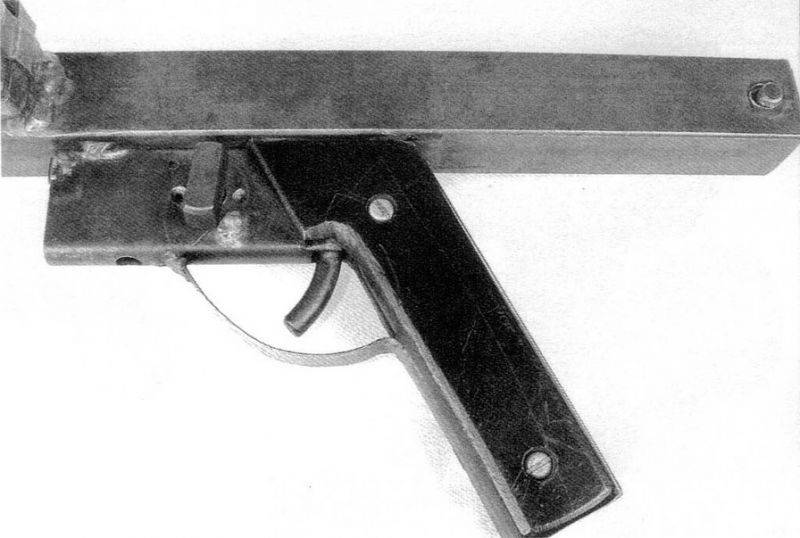

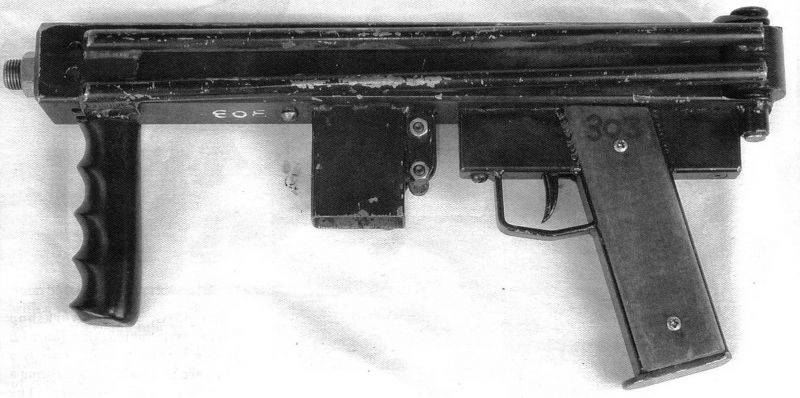

Information